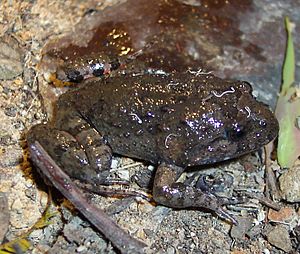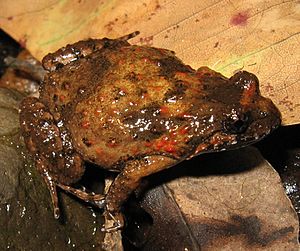Tusked frog facts for kids
Quick facts for kids Tusked frog |
|
|---|---|
 |
|
| Male | |
 |
|
| Female | |
| Conservation status | |
| Scientific classification | |
 |
|
| Range of the tusked frog |
The tusked frog (Adelotus brevis) is a special type of ground-dwelling frog. It lives in eastern Australia, from Queensland down to New South Wales. This frog is the only species in its group, called Adelotus. The name adelotus means "unseen," and brevis means "short."
Contents
What Does the Tusked Frog Look Like?
The tusked frog is quite unique because the female is smaller than the male. This is unusual for frogs in Australia! Males can grow up to about 5 centimeters (2 inches) long. Females are a bit smaller, reaching about 4 centimeters (1.6 inches).
Why Is It Called a Tusked Frog?
The name "tusked frog" comes from small, pointy parts on its lower jaw. These look a bit like tiny tusks. In males, these "tusks" can be about 5 millimeters (0.2 inches) long. You can only see them when the frog opens its mouth.
These bony tusks are actually changed teeth. They stick out from the middle of the lower jaw. When the frog closes its mouth, the tusks fit into special grooves on the upper jaw. Both males and females have them, but they are bigger in males.
How Male Tusked Frogs Fight
Male tusked frogs have been seen "locking jaws" with each other. This is similar to how male deer lock antlers when they fight to show who is stronger. Male tusked frogs have a much bigger head compared to their body size. Females have smaller heads. Males are known to bite each other under the head and around the neck during these fights. This fighting behavior probably led to males having bigger heads, bodies, and tusks. These features help them win fights.
Colors and Markings
The top (dorsal) side of the tusked frog is usually brown. But it can also be olive green or black. It has small bumps, warts, and dark, uneven markings. Often, there's a marking that looks like a butterfly between its eyes.
The bottom (ventral) side of this frog is much more colorful. It has a marbled pattern of black and white. You can also see flashes of red on its groin and back legs. Male and female frogs have different patterns on their bellies. Their fingers and toes are round and do not have webbing.
Where Do Tusked Frogs Live and What Do They Do?
Tusked frogs live near dams, ditches, flooded grassy areas, and creeks. They can be found in rainforests, wet forests, and woodlands. They live in both coastal areas and higher-up regions. However, their numbers have dropped in many highland areas, especially in the New England Tablelands of New South Wales.
Reproduction and Life Cycle
Male tusked frogs build hidden nests. They make these nests in leaf litter and plants in streams or at the edges of dams. The male makes a call that sounds like "tok-tok" from his nest. This makes them hard to find!
Breeding happens in spring and summer. The female lays her eggs in a foamy mass inside the nest. The nest keeps the eggs hidden from direct sunlight. The eggs are white and do not have any color.
During the breeding season (October to December), males build foam nests in ponds and swamps. These nests are hidden from the sun. A female can lay over 600 eggs in one floating foam mass. The male frog guards these eggs until they hatch into tadpoles. The tadpoles grow for about two to three months. They reach about 3 to 3.5 centimeters (1.2 to 1.4 inches) long. Then, they change into tiny froglets that look like small adult frogs.
Protecting the Tusked Frog
The tusked frog is listed as "near threatened" by the IUCN Red List. This means their numbers are likely decreasing. A big reason for this decline is a disease called chytridiomycosis, which affects amphibians.
The group of tusked frogs living in the Southern Tablelands of New South Wales is listed as endangered. This is because the species has disappeared from other parts of its former Tablelands home.
Threats to Their Survival
The main threats to tusked frogs are human activities. Building new cities and farms causes their homes to be damaged or disappear. Also, new species brought into the area are causing problems. For example, the eastern mosquitofish (Gambusia holbrooki) eats the frog's young. Weeds also grow and take over the natural plants that the tusked frog needs.
Gallery
See also
 In Spanish: Adelotus brevis para niños
In Spanish: Adelotus brevis para niños





